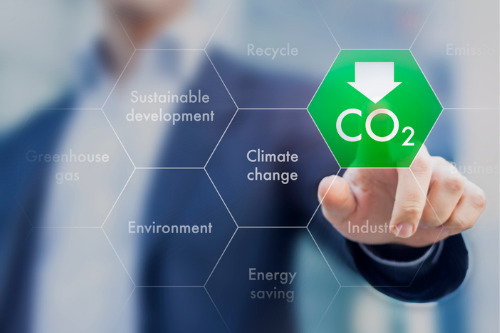

Climate change is one of the biggest challenges we face as a society. With climate-related catastrophe losses continuing to climb, insurers are in a unique position to recognise just how high the stakes of climate change truly are. In response, many have started to introduce carbon reduction plans to mitigate their business’s impact on the environment.
Swiss Re recently announced new measures to support its transition to a carbon net-zero company by 2050. These measures include an ambitious carbon reduction target for its investment portfolio of 35% by 2025, as well as fully phasing out of thermal coal for treaty re/insurance across its property, engineering, casualty, credit & surety and marine cargo lines of business in OECD countries by 2030 and in the rest of the world by 2040.
In addition to that, Swiss Re has become the first multinational company to introduce a triple-digit real internal carbon levy on direct and indirect operational emissions. The Carbon Steering Levy, which the firm says provides “a strong incentive to further reduce its operational emissions,” has been set as US$100 per ton CO2 as of 2021 and will gradually increase to US$200 per ton by 2030.
Swiss Re is leading by example as the world moves towards a low carbon footprint. By keeping global warming to well below 2˚C from pre-industrial levels, the target is to reduce greenhouse gas (GHG) emissions to net-zero by 2050. To achieve that goal, climate science says that 10–20 billion tons of carbon emissions will need to be removed from the atmosphere each year, which is a rather daunting but doable task.
“The quest towards decarbonising the economy clearly starts with clean energy [and] energy efficiency,” said Patrick Raaflaub, group chief risk officer at Swiss Re. “But even if all of our efforts in those areas are successful, there will still be significant carbon emissions, which will have to be directly removed from the atmosphere.”
Remaining emissions need to be removed from the atmosphere through biological or technical means, and they must be permanently stored. This can be achieved via the use of negative emission technologies (NETs), which typically fall into three categories: nature-based processes that use natural plants to capture carbon dioxide from the air; technological processes that use engineering tools; and a hybrid approach of natural and technological processes.
“Carbon removal solutions are a very interesting and dynamic field of technology right now, but they’re also in an infancy stage,” said Raaflaub. “There are a few promising technologies, but right now the only place where they work is in a lab or in a very small context. The next phase will be continuing to develop these technologies to a point where they can work at scale.”
Nature-based solutions like blue carbon (the carbon stored in coastal and marine ecosystems like mangroves, tidal marshes and seagrass meadows) and afforestation (introducing trees to an area that has previously not been forested) are now being recognised widely for their role in mitigating climate change, and the technology needed to support these solutions is quite mature. But as Raaflaub pointed out, these solutions also compete with other essential uses of nature, like food production, meaning the world will have to rely on technological processes to achieve carbon removal.
Engineering-backed carbon removal solutions are in a “nascent” stage, said Raaflaub, but there are some technologies that are starting to reap rewards. For example, bioenergy with carbon capture and storage, or BECCS, has become one of the most crucial NETs in recent years. BECCS works through the combustion of biomass (like crops and biological waste), while capturing the emissions and storing them below ground, thus eliminating GHG addition to the atmosphere.
“If you think about NETs - where they are in their development, and how rapidly they need to scale up in the coming decades - it’s clear that we’re looking at a very significant opportunity for the insurance industry,” Raaflaub said. “All of these solutions will need insurance protection for traditional property risks, engineering risks, and so on. They will challenge us in terms of understanding them, and maybe they will even challenge (to some extent) our risk appetite. But it’s not the first time that the insurance industry has marched side-by-side in significant technological development, and I think that’s what will be needed.”
There are also reputational risks involved with the potential failure or reversal of NETs, especially if they leak carbon dioxide back into the atmosphere over time. Raaflaub added: “If you fund a nature-based solution like afforestation, and that forest burns in a wildfire, that stored carbon will be released. That’s a challenge, but it’s also an opportunity for the insurance industry to provide some protection.”
By 2050, Raaflaub expects the carbon removal industry to be as big as the oil and gas industry is today. “That is not an unrealistic expectation,” he said. “It gives you an idea of the magnitude of this sector, and I believe anyone who explores, pioneers and becomes front-runners in this space will actually benefit a lot from the early experience.”
